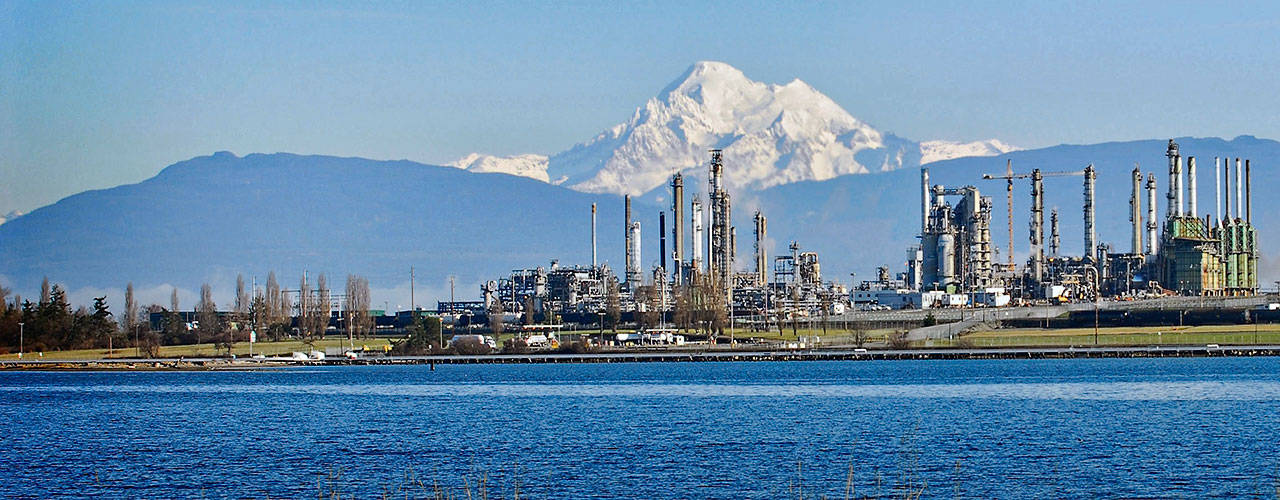The Skagit County Hearing Examiner will make a decision in early December about the Anacortes Refinery’s proposal to manufacture and export xylene to Asia.
Around 50 citizens, including members of the Swinomish Nation and at least 20 islanders, testified at a public hearing in Mount Vernon on Thursday, Nov. 2. Nearly 150 people were in attendance. The refinery is owned by Andeavor (formerly called Tesoro).
“Xylene is highly volatile and toxic and people need to wear protective gear around it,” San Juan Island resident Lovell Pratt told the Journal.
The hearing was for a shoreline permit that would enable Andeavor to produce xylene, a petrochemical used in making plastics and synthetics. The hearing examiner’s decision is expected no later than Dec. 4. If approved, the project is expected to be completed by the end of 2018.
There are two components to the proposal Kyle Loring, lawyer of Friends of the San Juans, explained to the Journal. Phase one of the project involves upgrades to the current plant to produce low sulfur fuels and less pollution, which he said is a good thing, and has almost universal support. The second part involves pipes and upgrades for the production of xylene.
In producing xylene, Andeavor is looking to create a more diverse product line. It could result in 20 jobs, according to the environmental impact statement, which led to some, like Stephanie Hamilton, with the Anacortes Chamber of Commerce, to testify in favor of the project.
Many testified against the proposal, citing health concerns in the case of a spill, an increase in vessel traffic and ferry disruptions. Pratt noted there was dramatic testimony at the hearing regarding explosions in China’s manufacturing plant. Some who testified said accidents such as explosions and spills were not adequately addressed in the impact statement. James said the EIS did not properly assess worse case scenarios.
“The EIS is not, in my view, in compliance with RCW 90.56.010 (28),” San Juan County Health Officer Dr. Frank James said, adding that the RCW states a worst-case spill is defined as when a vessel spills its entire cargo and fuel, which would be complicated by adverse weather conditions.
“There were four issues that I addressed with the hearing examiner on the human health and environmental impacts that were inadequately addressed in the Environmental Impact Statement,” said James. “[They] are significant problems with the current EIS and should be addressed if possible before this project is allowed to move forward. They are easily foreseeable, significant and have a real risk to both the environment and human health.”
James’ concerns included: ensuring residents are educated about the hazards of a xylene spills and how they differ from an oil spill; addressing inadequate analysis of a worst-case scenario spill; coming up with strategy to minimize human health and environmental impacts in case of a mixed spill; and separating two aspects (producing lower sulfur fuels and expanding into xylene) of the project so that the first phase may continue regardless of the proposal.
James is worried about residents attempting to help in the event of a spill. He said many believe the right thing to do is go to shore and assist with clean-up until trained and equipped professional staff arrives, but without proper education and personal protective equipment, those citizens would expose themselves to toxic flammable fumes. The proposed expansion would also result in 120 tanker trips in and around the islands annually, at a time when Kinder Morgan in Canada also has a proposed expansion project that would result in increased vessel traffic through the San Juans and when the endangered Southern resident orca whales are struggling to find their food source: the endangered Chinook salmon.
“I am concerned that this additional tanker traffic increases the chances that the Southern resident killer whales may go extinct either because of additional harassment by noise and vessel traffic or by a catastrophic marine accident,” testified Val Veirs, a San Juan Island resident who has been studying the effects of underwater noise on local orcas. Concern over impacts to the island economy due to ferry disruptions was also brought up at the hearing. An additional 120 trips annually, could increase the likelihood of an accident near the Anacortes ferry terminal, which could be devastating to an economy and community dependent on ferries.
For more information, see the Final EIS at tesoroanacorteseis.blob.core.windows.net/media/Default/Library/2017_07_10_Tesoro_Anacortes_CPUP_Final_EIS.pdf.



